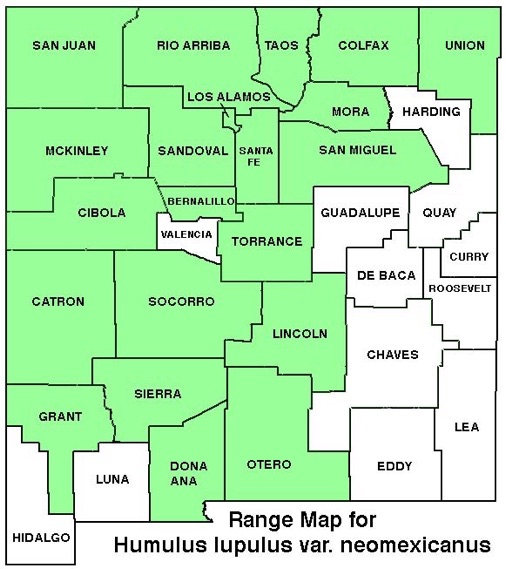WILDFLOWERS OF NEW MEXICO

This sprawling, climbing vine can reach 30 feet long with male and female flowers on separate plants (dioecious). Note the deeply lobed leaves and clusters of dangling, cone-like female flowers. The plant spreads with rhizomes.
FLOWER: June–October. Female flowers in cone-like clusters with greenish-yellow bracts; clusters dangle and are 3/8–2 3/8 inches long (1–6 cm). Male flowers on separate plants are tiny, whitish-yellow in spike-like clusters 2 3/4–6 inches long (7-15 cm).
LEAVES: Opposite with stems (petioles) shorter than the blades. Blades rounded in outline, deeply cut into 3–7 lobes (palmate), strongly veined and toothed, tips pointed.
HABITAT: Moist sandy, gravelly soils along steams, canyons, meadows, open areas; pinyon-juniper woodlands, ponderosa pine-Gambel’s-oak, spruce-fir-aspen forests.
ELEVATION: 6,000–9,000 feet.
RANGE: AZ, CA, CO, NM, NV, UT; Rocky Mts. and westward, Great Plains and Great Lakes states, Northeast, New England.
SIMILAR SPECIES: The palmate, toothed leaves and classic hop flowers help distinguish this vine.
NM COUNTIES: Widespread in NM, except eastern plains, in mid- to high-elevation, moist habitats: Bernalillo, Catron, Cibola, Colfax, Dona Ana, Lincoln, Los Alamos, Luna, McKinley, Mora, Otero, San Juan, San Miguel, Sandoval, Santa Fe, Sierra, Socorro, Rio Arriba, Taos, Torrance, Union.
NOTES: Hops vine is widely used ornamentally. The European H. lupulus var. lupulus is commercially grown for beer flavoring, and probably has introgressed with the native variety.









COMMON HOPS
HUMULUS LUPULUS VAR. NEOMEXICANUS
Hemp Family, Cannabaceae
Perennial vine



























THE CONTENTS OF THIS WEBSITE ARE COPYRIGHTED AND CANNOT BE USED
WITHOUT PERMISSION OF GEORGE OXFORD MILLER
















EMAIL ME
Female flowers are hidden by bracts (arrow) stacked in a cone-like cluster. (Jemez Mountains)









Palmate leaves can have 3–7 deeply cut, toothed lobes. (Jemez Mountains)


























